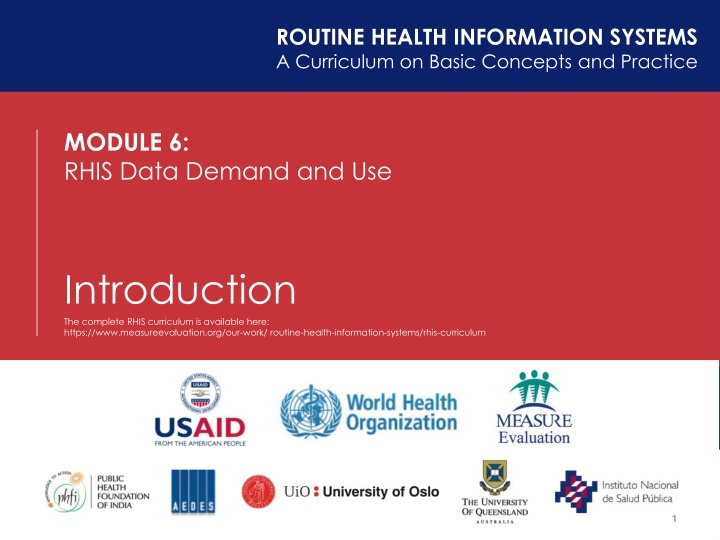
RHIS Data Demand and Use: Enhancing Health Information Systems
Explore Module 6 of the Routine Health Information Systems curriculum focusing on the importance of data utilization for program planning, policy development, and service delivery. Learn how to analyze RHIS data effectively and implement actions for improved health system performance. Recommended references and sessions included.
Download Presentation

Please find below an Image/Link to download the presentation.
The content on the website is provided AS IS for your information and personal use only. It may not be sold, licensed, or shared on other websites without obtaining consent from the author. If you encounter any issues during the download, it is possible that the publisher has removed the file from their server.
You are allowed to download the files provided on this website for personal or commercial use, subject to the condition that they are used lawfully. All files are the property of their respective owners.
The content on the website is provided AS IS for your information and personal use only. It may not be sold, licensed, or shared on other websites without obtaining consent from the author.
E N D
Presentation Transcript
ROUTINE HEALTH INFORMATION SYSTEMS A Curriculum on Basic Concepts and Practice MODULE 6: RHIS Data Demand and Use Introduction The complete RHIS curriculum is available here: https://www.measureevaluation.org/our-work/ routine-health-information-systems/rhis-curriculum 1
Module 6: Learning Objectives By the end of this module, participants will be able to: Raise awareness of the importance of using data to inform program planning and policy development Appreciate how data-use interventions can improve an HIS Demonstrate skills to manage team meetings for RHIS data review that result in action plans linking data to specific program questions, upcoming decisions, and service performance improvement Demonstrate knowledge of how to use RHIS data for decision making at all levels of the health system Demonstrate problem-solving skills to move from data analysis and problem identification to action 2
Module 6: Structure Duration: 9 hours Number of sessions: 4 Session 1: Using Data to Inform Policy, Program Planning, and Service Delivery (1 hour, 30 minutes) Session 2: Linking Data with Action (3 hours) Session 3: Using Data to Inform Facility-level Management (2 hours, 30 minutes) Session 4: Using Data to Inform Community-Level Management (2 hours) 3
Module 6: Suggested References Chewicha, K. & Azim, T. (2013). Community health information system for family-centered health care: Scale-up in Southern Nations, Nationalities and People s Region (SNNPR) Ethiopia. Ethiopia Ministry of HealthQuarterly Health Bulletin, 5(1):49-53. Retrieved from http://www.cpc.unc.edu/measure/resources/publications/ja-13-161 Judice, N. (2009). Seven steps to use routine information to improve HIV/AIDS programs: A guide for HIV/AIDS program managers and providers. Chapel Hill, NC, USA: MEASURE Evaluation, University of North Carolina. Retrieved from http://www.cpc.unc.edu/measure/our- work/data-demand-and-use/7-steps-to-improve-hiv-aids-programs LaFond, A., et al. (2003). Using data to improve service delivery: a self- evaluation approach. Retrieved from http://www.cpc.unc.edu/measure/resources/publications/sr-03-12/ 4
Module 6: Suggested References Marsh, D. (2000). Population-based community health information systems. In T. Lippeveld, R. Sauerborn, & C. Bodart. (Eds.), Design and implementation of health information systems (pp. 146 175). Geneva, Switzerland: World Health Organization. Retrieved from http://apps.who.int/iris/handle/10665/42289 MEASURE Evaluation. (2011). Tools for data demand and use in the health sector: Framework for linking data with action. Chapel Hill, NC, USA: MEASURE Evaluation, University of North Carolina. Retrieved from http://www.cpc.unc.edu/measure/resources/publications/ms-11-46-b 5
ROUTINE HEALTH INFORMATION SYSTEMS A Curriculum on Basic Concepts and Practice This presentation was produced with the support of the United States Agency for International Development (USAID) under the terms of MEASURE Evaluation cooperative agreement AID-OAA-L-14-00004. MEASURE Evaluation is implemented by the Carolina Population Center, University of North Carolina at Chapel Hill in partnership with ICF International; John Snow, Inc.; Management Sciences for Health; Palladium; and Tulane University. The views expressed in this presentation do not necessarily reflect the views of USAID or the United States government. 6
